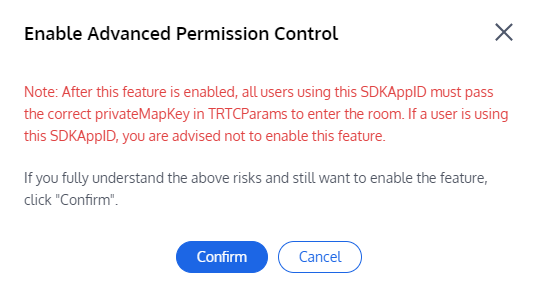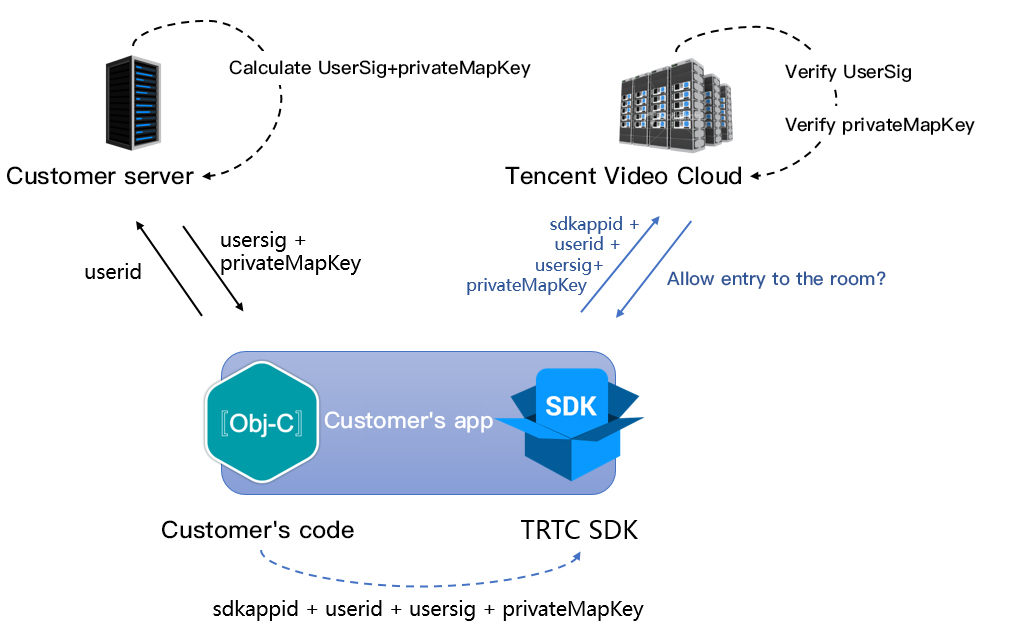高级权限控制
最后更新时间:2024-08-09 22:25:01
内容介绍
如果您希望给某些房间中加入进房限制或者上麦限制,也就是仅允许指定的用户去进房或者上麦,而您又担心在客户端判断权限很容易遭遇破解攻击,那么可以考虑开启高级权限控制。
在如下场景下,您并不需要开启高级权限控制的:
情况1:本身希望越多的人观看越好,对进入房间的权限控制无要求。
情况2:对攻击者破解客户端的防范需求不迫切。
在如下场景下,建议您开启高级权限控制以获得更佳的安全性:
情况1:对安全性要求较高的视频通话或者语音通话场景。
情况2:对不同房间设置不同进入权限的场景。
情况3:对观众上麦有权限控制的场景。
支持的平台
iOS | Android | Mac OS | Windows | Electron | Web 端 | Flutter |
✓ | ✓ | ✓ | ✓ | ✓ | ✓ | ✓ |
高级权限控制的原理
开启高级权限控制后,TRTC 的后台服务系统就不会仅校验 UserSig 这一个“进房票据”,还会校验一个叫做 PrivateMapKey 的“权限票据”,权限票据中包含了一个加密后的 roomid 和一个加密后的“权限位列表”。
由于 PrivateMapKey 中包含 roomid,所以当用户只提供了 UserSig 没有提供 PrivateMapKey 时,并不能进入指定的房间。
PrivateMapKey 中的“权限位列表”使用了一个 byte 中的 8 个比特位,分别代表了持有该票据的用户,在该票据指定的房间中所拥有的八种具体的功能权限:
位数 | 二进制表示 | 十进制数字 | 权限含义 |
第 1 位 | 0000 0001 | 1 | 创建房间的权限 |
第 2 位 | 0000 0010 | 2 | 进入房间的权限 |
第 3 位 | 0000 0100 | 4 | 发送语音的权限 |
第 4 位 | 0000 1000 | 8 | 接收语音的权限 |
第 5 位 | 0001 0000 | 16 | 发送视频的权限 |
第 6 位 | 0010 0000 | 32 | 接收视频的权限 |
第 7 位 | 0100 0000 | 64 | 发送辅路(也就是屏幕分享)视频的权限 |
第 8 位 | 1000 0000 | 128 | 接收辅路(也就是屏幕分享)视频的权限 |
开启高级权限控制
步骤1:在 TRTC 控制台中开启高级权限控制
1. 前往 Tencent RTC 控制台 > 应用管理,单击需要修改功能配置的目标应用所在行的管理,选择左侧项目栏的高级功能。
2. 在高级权限控制中,单击右侧的启用高级权限控制右侧按钮,弹窗中单击 Confirm 完成启用。




注意:
当某一个 SDKAppid 开启高级权限控制后,使用该 SDKAppid 的所有用户都需要在 TRTCParams 中传入
privateMapKey 参数才能成功进房(如 步骤 2 所述),如果您线上有使用此 SDKAppid 的用户,请不要轻易开启此功能。步骤2:在您的服务端计算 PrivateMapKey
由于 PrivateMapKey 的价值就是为了防止客户端被逆向破解,从而出现“非会员也能进高等级房间”的破解版本,所以它只适合在您的服务器计算再返回给您的 App,绝不能在您的 App 端直接计算。
我们提供了 Java、GO、PHP、Node.js、Python、C# 和 C++ 版本的 PrivateMapKey 计算代码,您可以直接下载并集成到您的服务端。
语言版本 | 关键函数 | 下载链接 |
Java | genPrivateMapKey 和 genPrivateMapKeyWithStringRoomID | |
GO | GenPrivateMapKey 和 GenPrivateMapKeyWithStringRoomID | |
PHP | genPrivateMapKey 和 genPrivateMapKeyWithStringRoomID | |
Node.js | genPrivateMapKey 和 genPrivateMapKeyWithStringRoomID | |
Python | genPrivateMapKey和 genPrivateMapKeyWithStringRoomID | |
C# | genPrivateMapKey和 genPrivateMapKeyWithStringRoomID | |
C++ | genPrivateMapKey和 genPrivateMapKeyWithStringRoomID |
步骤3:由您的服务端将 PrivateMapKey 下发给您的 App


方案一:在 enterRoom 时传递给 SDK
这种进房时校验 PrivateMapKey 的方案比较简单,非常适合于在用户进入房间前就能将用户权限确认清楚的场景。
方案二:通过实验性接口更新给 SDK
在直播场景中,往往都会有观众上麦变成主播的连麦场景。当观众变成主播时,TRTC 会再校验一次进房时在进房参数
TRTCParams 中携带的 PrivateMapKey,如果您将 PrivateMapKey 的有效期设置得比较短,例如“5分钟”,就会很容易触发校验失败进而导致用户被踢出房间。要解决这个问题,除了可以延长有效期(例如将“5分钟”改成“6小时”),还可以在观众通过
switchRole 将自己的身份切换成主播之前,重新向您的服务器申请一个 privateMapKey,并调用 SDK 的实验性接口 updatePrivateMapKey 将其更新到 SDK 中,示例代码如下:JSONObject jsonObject = new JSONObject();try {jsonObject.put("api", "updatePrivateMapKey");JSONObject params = new JSONObject();params.put("privateMapKey", "xxxxx"); // 填写新的 privateMapKeyjsonObject.put("params", params);mTRTCCloud.callExperimentalAPI(jsonObject.toString());} catch (JSONException e) {e.printStackTrace();}
NSMutableDictionary *params = [[NSMutableDictionary alloc] init];[params setObject:@"xxxxx" forKey:@"privateMapKey"]; // 填写新的 privateMapKeyNSDictionary *dic = @{@"api": @"updatePrivateMapKey", @"params": params};NSData *jsonData = [NSJSONSerialization dataWithJSONObject:dic options:0 error:NULL];NSString *jsonStr = [[NSString alloc] initWithData:jsonData encoding:NSUTF8StringEncoding];[WXTRTCCloud sharedInstance] callExperimentalAPI:jsonStr];
std::string api = "{\\"api\\":\\"updatePrivateMapKey\\",\\"params\\":{\\"privateMapKey\\":"xxxxx"}}";TRTCCloudCore::GetInstance()->getTRTCCloud()->callExperimentalAPI(api.c_str());
std::string api = "{\\"api\\":\\"updatePrivateMapKey\\",\\"params\\":{\\"privateMapKey\\":"xxxxx"}}";mTRTCCloud.callExperimentalAPI(api);
常见问题
1. 线上的房间为什么都进不去了?
房间权限控制一旦开启后,当前 SDKAppid 下的房间就需要在
TRTCParams 中设置 privateMapKey 才能进入,所以如果您线上业务正在运营中,并且线上版本并没有加入 privateMapKey 的相关逻辑,请不要开启此开关。2. PrivateMapKey 和 UserSig 有什么区别?
UserSig 是 TRTCParams 的必选项,作用是检查当前用户是否有权使用 TRTC 云服务,用于防止攻击者盗用您的 SDKAppid 账号内的流量。
PrivateMapKey 是 TRTCParams 的非必选项,作用是检查当前用户是否有权进入指定 roomid 的房间,以及该用户在该房间所能具备的权限,当您的业务需要对用户进行身份区分的时候才有必要开启。
文档反馈

